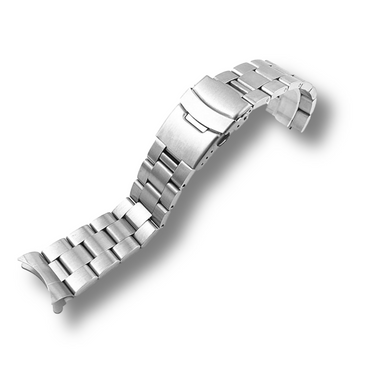Introduction
Welcome, fellow horology enthusiasts! Today, we embark on a fascinating journey through time to explore the captivating history of stainless steel in watchmaking.
At first glance, stainless steel may seem like an ordinary material, but its significance in the realm of horology is truly remarkable. Stainless steel, commonly referred to as "inox," is an alloy composed primarily of iron and chromium.
What sets it apart from other materials is its exceptional resistance to corrosion and staining. Initially developed by the brilliant metallurgist Harry Brearley in 1913, stainless steel's unique properties revolutionized not only the industrial sector but also the world of watchmaking.
A Brief Overview: Stainless Steel's Significance in Watchmaking
In the realm of timekeeping marvels, durability and style reign supreme. Stainless steel has emerged as a champion metal that effortlessly combines both these essential attributes.
Watchmakers quickly recognized that this alloy possesses extraordinary properties that make it ideal for crafting robust yet aesthetically pleasing timepieces. One crucial aspect where stainless steel excels is its unparalleled durability.
Unlike other materials prone to scratches or tarnishing, stainless steel can withstand everyday wear and tear with grace and resilience. Whether you're wearing your cherished Rolex or your trusty Apple Watch with a stainless steel band (yes, even our beloved smartwatches benefit from this alloy's merits), rest assured that their cases will retain their pristine appearance for years to come.
Furthermore, stainless steel offers immense versatility when it comes to design possibilities. Its sleekness harmonizes beautifully with any style - be it sporty or elegant - making it an ideal choice for both casual wearers and aficionados seeking refined luxury pieces.
The ability to seamlessly transition from a formal soirée with a polished stainless-steel dress watch to an adventurous weekend hike with a rugged stainless-steel diver's timepiece is what sets this alloy apart. Stainless steel's significance in watchmaking is not to be underestimated.
Its exceptional durability and ability to effortlessly blend style and functionality make it the material of choice for countless watchmakers worldwide. So, fasten your stainless steel apple watch band securely and prepare to delve into the captivating journey that led to the rise of this remarkable alloy in the horological world.
The Birth of Stainless Steel
Discovery of stainless steel by Harry Brearley in 1913
In the early 20th century, a remarkable breakthrough occurred in the field of metallurgy with the discovery of stainless steel. This pivotal moment can be attributed to the ingenuity of a British metallurgist named Harry Brearley, who made this serendipitous discovery in 1913. At the time, Brearley was working on developing erosion-resistant gun barrels for the military.
Little did he know that his experimentation would lead to one of the most important materials in watchmaking history. Brearley's key insight was recognizing that adding chromium to iron could dramatically enhance its resistance to corrosion and staining.
By increasing the chromium content to about 12-14%, he inadvertently created a new type of steel that possessed exceptional anti-rust properties. This alloy was aptly named "stainless" steel due to its ability to resist oxidation and maintain its lustrous appearance even under harsh conditions.
Explanation of the alloy composition and properties that make it unique
The unique composition of stainless steel lies in its combination of iron, chromium, and other elements such as nickel and molybdenum. The primary constituent is iron, which provides strength and structural integrity. Chromium, on the other hand, forms a protective layer on the surface when exposed to oxygen, rendering stainless steel highly resistant to rusting.
One crucial characteristic that sets stainless steel apart is its exceptional corrosion resistance. Unlike traditional carbon steels that readily oxidize when exposed to moisture or air, stainless steel forms an invisible barrier known as a passive layer.
This passive layer acts as a shield against external elements, preventing rust from forming and maintaining the metal's integrity over time. Additionally, stainless steel boasts impressive strength and durability while remaining relatively lightweight compared to other metals like titanium.
Its high tensile strength makes it ideal for watchmaking, ensuring that timepieces crafted from stainless steel can withstand daily wear and tear without losing their structural integrity. Moreover, stainless steel possesses an inherent elegance that enhances its appeal in the world of watchmaking.
The smooth and reflective surface of polished stainless steel exudes a timeless charm, captivating enthusiasts with its understated sophistication. Whether it's a brushed or polished finish, stainless steel exerts an alluring magnetism that complements various watch styles, from sports watches to dress watches.
The birth of stainless steel revolutionized the watchmaking industry, enabling the creation of timepieces that were not only aesthetically pleasing but also durable and long-lasting. As Brearley's groundbreaking discovery spread across the globe, luxury watch brands recognized the immense potential of this alloy.
Today, stainless steel remains a staple material for countless iconic watches adorning the wrists of horology aficionados worldwide. It has become synonymous with reliability, versatility, and enduring beauty in the realm of timekeeping—the perfect marriage between functionality and style.
The Rise of Stainless Steel Watches
Early Adoption by Luxury Watch Brands like Rolex and Patek Philippe
In the early 20th century, luxury watch brands such as Rolex and Patek Philippe recognized the immense potential of stainless steel in watchmaking. They were among the first to embrace this durable, corrosion-resistant material for their timepieces. One of the most iconic stainless steel watches in history is the Rolex Oyster Perpetual, which made its debut in 1926.
This remarkable timepiece revolutionized watchmaking with its groundbreaking waterproof case. The Oyster Perpetual was a game-changer, as it allowed wearers to explore aquatic environments without compromising on style or functionality.
Another legendary luxury watch brand that played a vital role in popularizing stainless steel watches was Patek Philippe. In 1932, they introduced the renowned Calatrava model, a classic dress watch crafted entirely from stainless steel.
This bold move challenged traditional notions that precious metals were essential for elegant timepieces. However, Patek Philippe's Calatrava proved that stainless steel could exude sophistication and timeless style.
Rolex Oyster Perpetual: The First Waterproof Stainless Steel Watch (1926)
The creation of the Rolex Oyster Perpetual marked a significant milestone in horological history. Designed by Hans Wilsdorf, this exceptional timepiece boasted an innovative case sealed with rubber gaskets to provide unparalleled water resistance. The combination of stainless steel and advanced technology resulted in a watch capable of withstanding challenging environments and adventurous activities like diving or sailing.
The success of the Oyster Perpetual not only solidified Rolex's reputation but also paved the way for future advancements in waterproof watch designs. Today, many modern dive watches owe their existence to this groundbreaking creation which forever changed how we perceive stainless steel watches.
Patek Philippe Calatrava: A Classic Stainless Steel Dress Watch (1932)
Patek Philippe's Calatrava collection is renowned for its timeless elegance and refined aesthetics. In 1932, the brand made a bold decision to introduce stainless steel versions of their iconic dress watches.
This move challenged conventional norms that associated luxury timepieces with precious metals like gold or platinum. The stainless steel Calatrava models quickly gained popularity among watch enthusiasts who admired the blend of understated sophistication and durability.
These watches became a symbol of tasteful elegance, suitable for formal occasions yet versatile enough to be worn daily. The success of these stainless steel dress watches cemented Patek Philippe's reputation as a trailblazer in the watchmaking industry.
Increased Popularity During World War II Due to Durability and Corrosion Resistance
During World War II, stainless steel watches experienced a surge in popularity due to their exceptional durability and corrosion resistance. Soldiers and pilots sought timepieces capable of withstanding harsh conditions on the battlefield, making stainless steel watches an ideal choice.
The alloy's ability to resist rust and tarnish even in challenging environments earned it a reputation for reliability. Stainless steel watches became must-have accessories for military personnel, further solidifying their status as symbols of strength and resilience.
Additionally, the scarcity of precious metals during wartime made stainless steel an attractive alternative for both manufacturers and consumers alike. Its affordability combined with its incredible endurance made it an ideal material for producing timepieces that could withstand the test of time.
Luxury watch brands like Rolex and Patek Philippe played pivotal roles in popularizing stainless steel watches. Their early adoption of this robust material showcased its versatility, leading to groundbreaking designs such as the Rolex Oyster Perpetual and Patek Philippe Calatrava series.
Moreover, increased demand during World War II demonstrated that stainless steel was not only stylish but also practical and reliable, further catapulting its popularity. Today, stainless steel watches continue to be highly sought after, evoking a sense of durability and timelessness that transcends trends and fads.
Stainless Steel Grades in Watchmaking
Overview of Stainless Steel Grades
When it comes to stainless steel in watchmaking, various grades are utilized to ensure the desired quality and performance. Let's dive into the three most commonly used grades: 316L, 904L, and 316F. 316L: This grade is often referred to as "marine grade" stainless steel due to its excellent corrosion resistance properties.
It contains a higher percentage of chromium, nickel, and molybdenum compared to other grades. The 316L stainless steel is highly resistant to pitting and staining, making it ideal for timepieces that may come into contact with moisture or chemicals.
904L: Considered an upgrade from 316L, 904L stainless steel takes corrosion resistance to another level. Its composition includes additional amounts of copper and molybdenum, enhancing its ability to withstand harsh environments such as saltwater.
Due to its exceptional anti-corrosive properties, this grade is often used by prestigious brands like Rolex. 316F: The "F" stands for free-machining stainless steel.
It is specifically designed for ease of machining without sacrificing essential characteristics like corrosion resistance and strength. Watchmakers appreciate this grade for its excellent workability when creating intricate components within timepieces.
Distinguishing Characteristics
Each stainless steel grade has distinguishing characteristics that make it suitable for specific watchmaking purposes. The allure of using 316L lies in its balance between cost-effectiveness and durability. It offers a good combination of strength and corrosion resistance while being relatively easy on the budget.
Many mid-range luxury watches utilize this grade due to these favorable qualities. On the other hand, the use of 904L brings exclusivity and added sophistication to watches.
Its capability to withstand extreme conditions, coupled with a unique aesthetic, makes it highly sought after by discerning collectors. Prominent timepieces such as the Rolex Submariner and Daytona feature cases and bracelets made from 904L stainless steel.
316F, with its machinability properties, allows for intricate detailing in watch components. This grade is often utilized in intricate movements or parts that require precision machining while retaining excellent corrosion resistance.
Watches Known for Specific Grades
Certain watches have gained recognition for their association with specific stainless steel grades. For example, Rolex has championed the use of 904L stainless steel within their models like the Submariner Date and GMT-Master II, showcasing the brand's commitment to exceptional quality.
Alternatively, brands like Omega have often utilized 316L stainless steel to create iconic timepieces such as the Speedmaster Professional Moonwatch and Seamaster Diver 300M. These models perfectly exemplify how this versatile grade can provide durability without compromising style.
It's fascinating how these different grades of stainless steel contribute to the overall aesthetic and functionality of watches. The choice of grade showcases a watchmaker's attention to detail and commitment to crafting timepieces that endure the test of time while retaining their elegance.
Understanding the various stainless steel grades used in watchmaking provides insight into both their distinct properties and relevance within horology. Whether it be the reliability of 316L, exclusivity of 904L, or precision offered by 316F, each grade plays a vital role in creating exceptional timepieces enjoyed by watch enthusiasts worldwide.
Finishing Techniques on Stainless Steel WatchesCreating Timeless Aesthetics
When it comes to stainless steel watches, the finishing techniques used play a crucial role in defining their appearance and character. Two popular finishing methods are the brushed finish and the polished finish, each offering distinct visual effects.
Let's delve into these techniques and explore some iconic timepieces that showcase their mastery.
Brushed Finish: The Art of Muted Elegance
A brushed finish is the most common technique employed to give stainless steel watches a refined matte appearance. This method involves rubbing abrasive materials against the metal's surface in a unidirectional manner, resulting in fine parallel lines or grain patterns.
Different brush patterns are used to create unique aesthetics. For instance, a horizontal brush pattern gives a watch an understated elegance, while vertical or radial brushes can add texture and depth.
Some manufacturers even experiment with cross-hatch or sunray patterns for an extra touch of sophistication. An excellent example of a brushed stainless steel watch is the iconic Rolex Submariner.
Its rugged design and expertly executed horizontal brushed finish exude timeless appeal, perfectly complementing its functionality as a sports watch. If you're seeking something more versatile for everyday wear, consider the Omega Speedmaster Professional Moonwatch with its vertical brushed finish.
This legendary timepiece not only boasts historical significance but also showcases how different brush patterns can enhance its visual allure.
Polished Finish: Reflecting Brilliance
A polished finish is all about achieving a mirror-like shine on the case and bracelet of a stainless steel watch. This technique involves using polishing compounds with progressively finer abrasives until achieving desired levels of smoothness and luster. To achieve different levels of polish, watchmakers employ various techniques.
Hand-polishing by skilled artisans ensures meticulous craftsmanship and attention to detail. Machine-polishing, on the other hand, allows for consistency and efficiency in producing a flawless finish.
One notable stainless steel watch renowned for its polished brilliance is the Rolex Datejust. Its gleaming surfaces capture light from every angle, transforming the timepiece into a statement of luxury and refinement.
If you prefer contemporary elegance with an edge, the TAG Heuer Carrera series offers stunning examples of brushed and polished stainless steel finishes combined. This juxtaposition creates a fascinating interplay between matte and shiny surfaces, making it an excellent choice for those desiring both sophistication and sportiness.
Whether you opt for a brushed or polished finish on your stainless steel watch, these techniques elevate its visual allure to new heights. The mastery exhibited by renowned watchmakers in creating these finishes ensures that your timepiece stands out as a reflection of both style and craftsmanship.
Stainless Steel Alternatives in Watchmaking
Other Materials Used as Alternatives to Traditional Stainless Steel
When it comes to watchmaking, stainless steel has long been the go-to material for its durability and versatility. However, in recent years, watchmakers have begun exploring alternative materials that offer unique characteristics and aesthetics. Let's take a closer look at some of these alternatives:
Titanium
Titanium has gained popularity as a material choice for watches due to its lightweight nature and exceptional strength. It is known for being highly resistant to corrosion and scratches, making it an excellent option for those looking for a durable timepiece. Titanium watches are comfortable to wear and often feature a modern, sleek design that appeals to contemporary watch enthusiasts.
Ceramic
Ceramic has emerged as another intriguing alternative to stainless steel in watchmaking. This material is prized for its scratch-resistant properties and ability to retain its color over time.
Ceramic watches are often associated with a luxurious appearance, thanks to their smooth surface and high-quality finish. Additionally, ceramic's hypoallergenic nature makes it an ideal choice for those with sensitive skin.
Carbon Fiber
For those seeking an avant-garde look, carbon fiber offers a compelling option. Known for its lightness and exceptional strength-to-weight ratio, carbon fiber has become popular in sports watches. Its unique texture adds visual interest while providing durability comparable to stainless steel.
Conclusion
As we've explored the history of stainless steel in watchmaking and delved into possible alternatives, it becomes evident that the world of horology continues to evolve. While stainless steel remains a timeless choice cherished by many watch enthusiasts worldwide, the emergence of new materials provides exciting opportunities for innovation within the industry.
Whether it's titanium's lightweight resilience or ceramic's elegant appeal, these alternative materials offer watchmakers the chance to experiment and create timepieces that cater to a diverse range of tastes. As technology advances, we can expect even more innovative materials and combinations to grace our wrists in the future.
So, whether you prefer a classic stainless steel apple watch band or are drawn to the allure of alternative materials, find solace in knowing that there is a perfect watch out there for everyone. The journey of timekeeping continues with endless possibilities for craftsmanship and style.
























